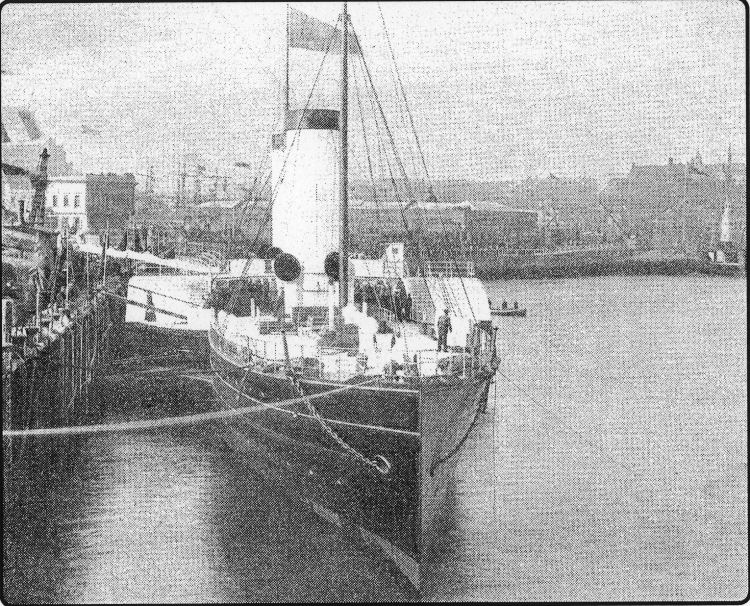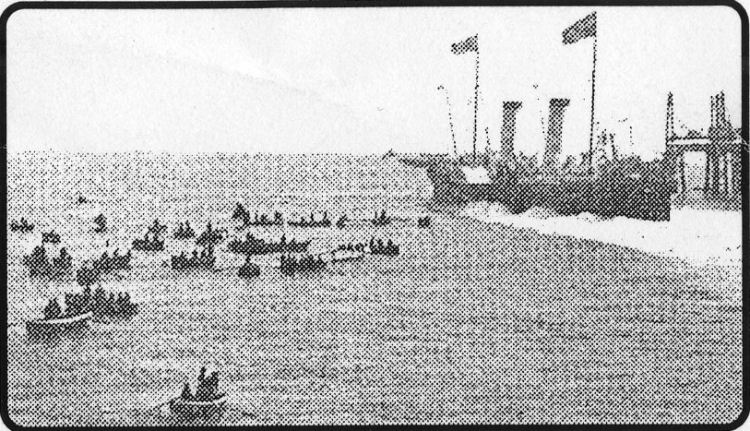
Published 25 January 2001


Great Queen
A CENTURY ago this week the Folkestone Herald staff, like millions of people
throughout the British Empire, were in mourning, following the death of
Queen Victoria, at Osborne, four years after she celebrated her Diamond
Jubilee, on completing a remarkable 60 years on the throne.
Every column of news and advertisements was separated, not by the usual thin
rule, but a thick black line signifying mourning.
And there were thousands of words in praise of a remarkable monarch.
The Folkestone Herald had good reason to look back and reflect on Her
Majesty's visits to Folkestone, one in 1855, when she was accompanied by her
husband, Prince Albert, and again, in 1899, when she made her last visit to
France via Folkestone, in company with several members of her family.
That event was covered in great detail by the local papers at the time. Even
the name of \ the driver of the royal train was ) named, as Adam Baker, and
that of his fireman, John Davis. But it did not say whether they were local
men.
Charles Croucher, of the Junction Station, was named as 'pilot' for the
short journey down to the harbour, and the guards as Messrs Cheeseman and
Hinckley.
Queen Victoria, sat in what was described as a "wheeled
chair" was carried from her royal saloon carriage by two attendants.
Headlines on stories telling of the Queen's death and the official
announcement of King Edward Vll's accession to the throne, reflected the
great reverence and admiration with which the Queen was held.
They told of the gloom caused by her final illness, the suspense as daily
bulletins on her health were posted, and the world-wide sympathy, when she
died.
Herald gift
The Herald looked back on the 1899 visit with satisfaction because by
"gracious" consent it was granted the right to present the Queen with a
"gorgeously-bound volume of the most exquisite views obtainable in
Folkestone."
The gift, trumpeted the paper meant "our beloved Queen" would be "able to
appreciate the beauties of the town."
Our popular columnist of the time, called Felix, wrote that it was a proud
day for Folkestone adding that some people were
sceptical that Queen Victoria would travel via our port.
The Saturday of her visit dawned a trifle misty but the royal train arrived
under a blue sky and practically the whole population seems to have been
there to line the route to the port from the Junction Station.
Two minutes early the royal train steamed into the Junction and it is said
the cheers could be heard down at the harbour.
One enterprising photographer climbed a mast of the Calais Douvres steamer
which was to take the royal party across the Channel, to get a bird's-eye
view of the Queen's welcome. I wonder if that picture survives?
Our man Felix, one of only two Press men on board the Calais-Douvres,
suggested the Queen's embarkation for France should be marked by a suitable,
inscribed plaque on the pier. A most suitable place, particularly in view of
the fact that King Edward VII, when the Prince of Wales, had laid the
foundation stone of that pier.
That was in 1881 when he "opened" the newly built Seabrook sea wall defences
and then rode to Folkestone in an open carriage drawn by four horses to lay
the foundation stone of port improvements.
The Prince's royal train had arrived in Hythe's then main line station, and
he was welcomed by the mayors of Hythe
and Folkestone, Messrs W.B. Mackeson and W. Tolputt, respectively.
Handsome decorations lined the royal route from Seabrook to Folkestone
harbour, notable being a series of ornamental arches, including one by the
Royal Pavilion Hotel at the port.
After laying a 16-ton foundation stone incorporating a silver casket
containing local newspapers, coins of the day etc, the Prince, before his
departure thanked local people for his great welcome.
QUEEN Victoria boards the steamer Calais-Douvres at the port in 1899 and,
above local fishermen in small boats wave farewell.
 |
Folkestone’s ‘Trafalgar’ mayor who met Prince
«f A AS THE nation mourned the passing 19U1 of Queen Victoria the
Folkestone Herald reflected on past royal visits and, apart from
recalling the Queen's welcome to the district on two occasions, looked
back to the day the Prince of Wales, who now became King Edward VII,
visited Folkestone to present Colours to the “Royal Canadians" at
Shorncliffe - the first regiment raised outside the UK. That ceremony
also saw the Prince's first official military engagement after assuming
the rank and uniform of a Colonel of the Guards. Riding a horse, he
inspected a large assembly of troops at the camp, after the official
welcome to the district by the town's “Trafalgar” Mayor - Commander
Gilbert Kenni-cott, ex Royal Navy. Thanking him for his welcome the
Prince remarked that “he was glad to be introduced to an old Trafalgar
officer” a reference to the gallant captain's services in that memorable
Royal Navy action. Referring to Queen Victoria's funeral the Herald
noted that the Dover wholesale grocery firm of Richard Dickeson & Co had
undertaken the contract at short notice to provide breakfast and dinner
for no less than 25,000 troops who were to line the funeral route.
|
Dymchurch railway plans 'could never be success’
AT THE local inquiry into the plans to build
the Romney, Hythe & Dymchurch light railway Mr Alfred Baynton, Secretary
of the East Kent Road Car Company, who might be said to have a vested
interest, told the Inspector that in his view the railway could never be
successful, there being such a short summer season in which to attract
holiday traffic. Another witness said there was little hope of income
from farmers who might wish to transport their sheep across the Marsh
for transfer to main line trains at the most convenient point. One fear
was that the line would be built and then left derelict when it failed.
Two hundred children of members of a local Women's Conservative and
Unionist Association were entertained with a tea at Hythe Institute, a
happy party numbering around 250 being waited on by the branch committee
led by Mrs FW Butler, entertained by a professional conjuror, and each
given a gift. And so the parties went on ail over the district as local
organisations celebrated a New Year. It wasn’t only the League of
Cheerful Sparrows who brought cheer to the children. Newly formed Hythe
Orchestral Society, with 20 interested musicians, was appealing for more
string players.
|
S.0.S.from elderly hit by a winter coal shortage
M QCi 'ROAMER' in his 'Talk of the Town’ col-J- umn told of an S.O.S.
appeal from the secretary of the Mayor's Coal Fund, saying there were
over 500 applications from the elderly and needy for help with winter
fuel costs. At the same time Hythe Fuel Overseer MJH Girling warned
everyone to use coal sparingly. Roamer observed that the cost of coal
had more than doubled recently. The local seafaring community was
mourning the death of Mrs Ellen Tart, of East View Dungeness, wife of
William Tart, many years head launcher of Dungeness lifeboat. Mrs Tart
was the daughter of a former Chief Officer of Coastguards at Dungeness.
And, on his estate near Dymchurch Lord Moyniham flew his flag at
half-mast in tribute to William Ovenden, a West Hythc farmer for 21
years, who had also been his gardener. A former farm bailiff at
Dymchurch Mr Ovenden served 17 years in the Royal Navy and did duty as
an Air Raid Warden in the Second World War. The Marine Pavilion. Hythe.
worried town councillors who said it was a blot on the 'Shop Window' of
the town. But councillors postponed discussion of plans to repair the
restaurant and refurbish the wcs, pending a report by the Borough
Surveyor. This was despite comments by an alderman who said it was a
disgrace to Hythe and the roof was unsafe.
|
First steps towards homes on ‘Few’s’ fighter airfield
M q^/%SHEPWAY Council's health and housing JL«7 I O committee was
recommending an in-depth study into the possible use of land at the
famous Battle of Britain airfield at Hawkinge, a decision which did
nothing to improve their standing with many local residents. Villagers
were proud of their links with the legendary “Few” who fought and won
the battle for command of the skies over “Hellfire Corner” and beyond as
Hitler threatened to invade the UK. The councillors’ decision followed
an about-turn by the environment ministry as to the suitability and
likely availability of the land for building homes. Their decision was
swayed by the pressure to build more homes to let at economic rents for
young people. Meanwhile work was set to begin on building a £6 million
mini-town on the outskirts of the town - an estate of 400 homes on a
former Folkestone golf course, including a Roman Catholic school, shops,
a church/community centre, children’s home and an old people's home.
Consent for the first part of the 50-acre site had been granted. “Ban
Water Cowboys” that was the call from a workling party set up by Shepway
Local Sports Advisory Council, after concern over the dangers off
bathing beaches posed by over-enthusiastic water skiers. They were said
to flout bye-laws over speed, and there were calls to make an example in
the courts of one or two helmsmen, before tragedy struck.
|
|



